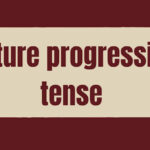The present perfect tense is a grammatical tense used to describe actions or events that occurred at an indefinite time in the past but have a connection to the present.
It is formed by using the auxiliary verb “have” or “has” followed by the past participle form of the main verb.
The basic structure of the present perfect tense is as follows:
Subject + have/has + past participle
Here are some examples:
1. I have studied English for five years.
2. She has finished her homework.
3. We have traveled to many countries.
4. They have seen that movie before.
5. He has written a book.
In these examples, the use of “have” or “has” indicates the present tense, while the past participle form of the verb (e.g., studied, finished, traveled, seen, written) shows that the action or event happened in the past.
The present perfect tense suggests a connection to the present because the action or event has relevance or impact on the present moment or is still ongoing.
It is important to note that “have” is used with plural subjects (e.g., I, you, we, they) and “has” is used with singular subjects (e.g., he, she, it).
FORMULA OR STRUCTURE
The formula for the present perfect tense is as follows:
[Subject] + [have/has] + [past participle]
Here’s a breakdown of each component:
1. Subject:
This refers to the noun or pronoun that performs the action of the sentence.
It can be in the first person (I, we), second person (you), or third person (he, she, it, they).
2. Have/Has:
The choice between “have” and “has” depends on the subject of the sentence.
“Have” is used with the first person (I, we), second person (you), and plural third person (they).
“Has” is used with the singular third person (he, she, it).
3. Past Participle:
The past participle is the third principal part of the verb and is usually formed by adding “-ed” or “-d” to the base form of regular verbs.
However, irregular verbs have specific past participle forms that need to be memorized.
For example, “walked” is the past participle of the regular verb “walk,” and “eaten” is the past participle of the irregular verb “eat.”
Here are a few examples using the formula:
– I have studied.
– She has finished her work.
– We have traveled to many countries.
– They have seen that movie.
– He has written a book.
In these examples, the subject is followed by the appropriate form of “have” (have or has) and then the past participle of the main verb (studied, finished, traveled, seen, written).
Certainly! Here’s a breakdown of the structure of the present perfect tense in positive, negative, and interrogative sentences:
Positive Sentence:
[Subject] + [have/has] + [past participle]
Example:
Subject: I
Have/Has: have
Past Participle: studied
Positive sentence: I have studied.
Negative Sentence:
[Subject] + [have/has not] + [past participle]
Example:
Subject: She
Have/Has: has
Not: not
Past Participle: finished
Negative sentence: She has not finished.
Interrogative Sentence:
[Have/Has] + [subject] + [past participle] + [?]
Example:
Have/Has: Have
Subject: you
Past Participle: seen
Interrogative sentence: Have you seen?
In the interrogative sentence, the auxiliary verb “have” or “has” is placed at the beginning, followed by the subject.
Then, the past participle form of the verb is used, followed by a question mark to indicate that it is an interrogative sentence.
It’s important to note that in negative sentences, the word “not” is inserted between the auxiliary verb and the past participle to indicate negation.
RULES
Here are some key rules for using the present perfect tense:
1. Formation:
The present perfect tense is formed by using the auxiliary verb “have” (for first person, second person, and plural third person subjects) or “has” (for singular third person subjects), followed by the past participle form of the main verb.
2. Time Frame:
The present perfect tense is used to describe actions or events that started in the past and have a connection to the present.
It emphasizes the result or the impact of the action or event on the present moment.
3. Indefinite Time:
The present perfect tense does not specify an exact time when the action or event occurred.
It is used for actions or events that happened at an indefinite time in the past.
4. Completed Actions:
The present perfect tense is used to talk about actions or events that have been completed or finished.
It suggests that the action is not ongoing or continuous.
5. Unspecified Duration:
The present perfect tense is often used when the duration of the action or event is not specified or not relevant to the conversation.
It focuses on the result or the present consequences of the action.
6. Signal Words:
Certain signal words or phrases are commonly used with the present perfect tense, such as “already,” “yet,” “ever,” “never,” “just,” “recently,” and “so far.” These words indicate a connection between the past and the present.
7. Negative and Interrogative Forms:
The present perfect tense can be used in negative sentences by adding “not” between the auxiliary verb and the past participle.
In interrogative sentences, the auxiliary verb is placed at the beginning of the sentence before the subject.
8. States and Experiences:
The present perfect tense is also used to talk about states or experiences that started in the past and continue to the present.
For example, “I have lived in this city for ten years.”
Remember that the context and specific usage of the present perfect tense may vary depending on the situation and the intended meaning.
HOW TO EXPLAIN PRESENT PERFECT TENSE TO STUDENTS
Explaining the present perfect tense to students can be done in a clear and simple manner. Here’s an approach you can use:
1. Start with the Purpose:
Explain that the present perfect tense is used to talk about actions or events that happened in the past but have a connection to the present. Emphasize that it shows the result or impact of the action on the present moment.
2. Formation:
Discuss the formation of the present perfect tense by using the auxiliary verb “have” or “has” followed by the past participle form of the main verb.
Provide examples to illustrate this structure.
3. Time Frame:
Highlight that the present perfect tense doesn’t specify a specific time when the action occurred.
It is used for actions that happened at an indefinite time in the past.
4. Completed Actions:
Explain that the present perfect tense is used for actions or events that have been completed or finished.
It suggests that the action is not ongoing or continuous.
5. Examples and Context:
Give relevant examples to make it easier for students to understand.
Use sentences that involve everyday activities, such as “I have eaten breakfast” or “She has watched a movie.”
6. Signal Words:
Introduce common signal words or phrases that are associated with the present perfect tense, such as “already,” “yet,” “ever,” “never,” “just,” “recently,” and “so far.” Explain that these words indicate a connection between the past and the present.
7. Practice Exercises:
Provide practice exercises for students to reinforce their understanding.
This can involve transforming sentences into the present perfect tense or completing sentences using the correct form of the verb.
8. Real-Life Examples: Show how the present perfect tense is used in real-life situations, such as talking about personal experiences, recent news events, or achievements.
9. Negative and Interrogative Forms:
Explain how the present perfect tense can be used in negative sentences by adding “not” between the auxiliary verb and the past participle.
Show how to form interrogative sentences by placing the auxiliary verb at the beginning of the sentence before the subject.
10. Review and Recap:
Summarize the key points and encourage students to ask questions if they have any uncertainties.
Review the main rules and provide additional examples to solidify their understanding.
Remember to adjust your explanations and examples based on the students’ proficiency level and age, ensuring that the language used is appropriate and understandable for them.
Exercise: Present Perfect Tense
Directions: Complete each sentence using the present perfect tense. Choose the correct form of the verb in parentheses.
1. She ______________ (visit) three different countries.
2. We ______________ (study) for the exam all week.
3. They ______________ (never try) sushi before.
4. He ______________ (play) soccer since he was a child.
5. I ______________ (finish) reading that book already.
6. The dog ______________ (eat) all its food.
7. My parents ______________ (travel) to Europe several times.
8. The concert ______________ (start) yet.
9. We ______________ (live) in this city for five years.
10. She ______________ (not see) that movie yet.
Answers:
1. has visited
2. have studied
3. have never tried
4. has played
5. have finished
6. has eaten
7. have traveled
8. hasn’t started
9. have lived
10. hasn’t seen
Learn more Tenses
- Simple present tense
- Simple past tense
- Simple future tense
- Present progressive tense
- Past progressive tense
- Future progressive tense
- Past perfect tense
- Future perfect tense
- Present perfect continuous tense
- Past perfect continuous tense
- Future perfect continuous tense
- Tenses in English grammar





1 thought on “Present Perfect Tense”